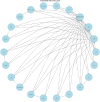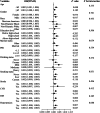Inflammatory burden index: associations between osteoarthritis and all-cause mortality among individuals with osteoarthritis
- PMID: 39138465
- PMCID: PMC11323649
- DOI: 10.1186/s12889-024-19632-1
Inflammatory burden index: associations between osteoarthritis and all-cause mortality among individuals with osteoarthritis
Abstract
Background: The newly described inflammatory burden index (IBI) reflects a patient's inflammatory burden. This study aimed to estimate the association between IBI, osteoarthritis (OA), and all-cause mortality in patients with OA.
Methods: We extracted the data of adults from the National Health and Nutrition Examination Survey database between 1999 and 2018. After using appropriate survey weights to correct for sample bias, we conducted multivariate logistic regression analyses to explore the association between IBI and OA across three models: in the unadjusted model, partially adjusted model (adjusting age, sex, race, education level, marital status, PIR, BMI, smoking status, drinking status, stroke, CVD, DM, and hypertension) and fully adjusted model (which included additional variables: HBA1C, ALT, AST, BUN, TC, and HDL). And the odds ratios (OR) and 95% confidence intervals (CI) were calculated. Similarly, using comparable survey weights and covariates adjustments, we employed Cox proportional hazards regression analysis to investigate the association between IBI and all-cause mortality in the other 3 models. The Cox proportional hazards regression models were fitted to calculate the hazard ratios (HR) and 95% CI of the association between IBI and all-cause mortality. A restricted cubic spline (RCS) was used to explore the nonlinear relationships between association effects. Subgroup analysis was performed to validate the reliability of their effects.
Results: In total, 22,343 eligible participants were included. Multiple logistic regression models revealed that participants with the highest IBI had 2.54 times (95%CI, 2.23, 2.90)) higher risk of OA than those with the lowest IBI in Model 1, whereas the OR was 1.21 (95%CI, 1.03, 1.42) in Model 2 and 1.23 (95%CI,1.05, 1.45) in Model 3. Multiple Cox regression models showed participants with the highest IBI had 186% (95%CI, 1.50, 2.31) times risk of developing all-cause death than those with the lowest IBI in Model 1. This trend remained stable in Models 2 (HR,1.54; 95%CI,1.22, 1.95) and 3 (HR, 1.41; 95%CI, 1.10, 1.80). The RCS revealed a significant positive association between IBI and OA risk. With respect to the association between IBI and all-cause mortality, a slight decrease in mortality was observed from the lowest quartile to the second quartile of IBI, and the mortality risk increased with increasing IBI. Subgroup analyses showed that age, cardiovascular disease, and hypertension were pivotal in the association of IBI with all-cause mortality, whereas the association of IBI with OA remained stable after stratification by other factors such as sex, race, education level, marital, smoking, and drinking status, hypertension, and most serological indices.
Conclusions: This study provides evidence of a positive association between IBI, OA, and all-cause mortality. IBI may be a promising signature for assessing the inflammatory burden in patients with OA, which, in turn, is conducive to precise references for high-risk population recognition, anti-inflammatory guidance, and reducing mortality intervention.
Keywords: All-cause mortality; CDC; Inflammatory burden index; NHANES; Osteoarthritis; Positive association.
© 2024. The Author(s).
Conflict of interest statement
The authors declare no competing interests.
Figures







Similar articles
-
Association of the Inflammatory Burden Index With Increased Mortality Among Cancer Patients: Insights From the NHANES Study.Immun Inflamm Dis. 2024 Dec;12(12):e70067. doi: 10.1002/iid3.70067. Immun Inflamm Dis. 2024. PMID: 39641241 Free PMC article.
-
Association between inflammatory burden index and all-cause mortality in the general population aged over 45 years: Data from NHANES 2005-2017.Nutr Metab Cardiovasc Dis. 2024 Jan;34(1):64-74. doi: 10.1016/j.numecd.2023.10.006. Epub 2023 Oct 10. Nutr Metab Cardiovasc Dis. 2024. PMID: 38016891
-
Association between cardiovascular health and all-cause mortality risk in patients with osteoarthritis.BMC Musculoskelet Disord. 2024 Aug 14;25(1):641. doi: 10.1186/s12891-024-07729-y. BMC Musculoskelet Disord. 2024. PMID: 39143482 Free PMC article.
-
Association Between Systemic Immune-Inflammation Index and Psoriasis, Psoriasis Comorbidities, and All-Cause Mortality: A Study Based on NHANES.Immun Inflamm Dis. 2024 Oct;12(10):e70050. doi: 10.1002/iid3.70050. Immun Inflamm Dis. 2024. PMID: 39467182 Free PMC article. Review.
-
Risk of all-cause mortality in patients with knee osteoarthritis: A systematic review and meta-analysis of cohort studies.Osteoarthr Cartil Open. 2024 Nov 8;7(1):100541. doi: 10.1016/j.ocarto.2024.100541. eCollection 2025 Mar. Osteoarthr Cartil Open. 2024. PMID: 39640421 Free PMC article. Review.
Cited by
-
Association between life's essential 8 and Parkinson's disease: a case-control study.BMC Public Health. 2025 Feb 1;25(1):411. doi: 10.1186/s12889-025-21648-0. BMC Public Health. 2025. PMID: 39893440 Free PMC article.
-
Association and Predictive Ability between Inflammatory Burden Index and Fever Following Endobronchial Forceps Biopsy in Lung Cancer Patients.J Inflamm Res. 2025 May 2;18:5911-5922. doi: 10.2147/JIR.S521144. eCollection 2025. J Inflamm Res. 2025. PMID: 40331157 Free PMC article.
-
Explainable machine learning-driven models for predicting Parkinson's disease and its prognosis: obesity patterns associations and models development using NHANES 1999-2018 data.Lipids Health Dis. 2025 Jul 17;24(1):241. doi: 10.1186/s12944-025-02664-w. Lipids Health Dis. 2025. PMID: 40676536 Free PMC article.
-
Letter to the editor for the article "associations between inflammatory burden index, prostate cancer, and mortality among middle-aged and elderly individuals".World J Urol. 2024 Dec 3;43(1):8. doi: 10.1007/s00345-024-05374-7. World J Urol. 2024. PMID: 39625495 No abstract available.
-
Association of the inflammatory burden index with the risk of pre-diabetes and diabetes mellitus: a cross-sectional study.BMC Endocr Disord. 2025 Mar 26;25(1):82. doi: 10.1186/s12902-025-01911-6. BMC Endocr Disord. 2025. PMID: 40140800 Free PMC article.
References
Publication types
MeSH terms
LinkOut - more resources
Full Text Sources
Medical

